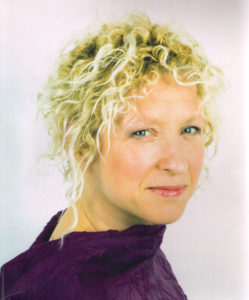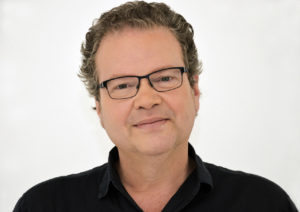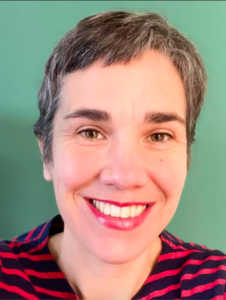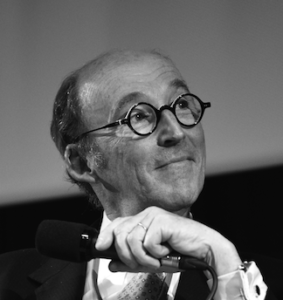Sophie Breton | Principal Dancer and Assistant to the Choreographer
After several years of competitive gymnastics, Sophie Breton discovered dance at Regina Assumpta College. She will then follow her training at LADMMI.
Upon graduation in 2008, she worked with Alan Lake for his piece Chaudières, déplacements et paysages. She then collaborated with Frédéric Marier, Thierry Huard and Sasha Kleinplatz, and with Ginelle Chagnon in the staging of excerpts from the work of Jean-Pierre Perreault. She was a member of the O Vertigo company for three years.
Today, Sophie works with Jacques-Poulain Denis, Virginie Brunelle (Complexe des genres, À la douleur que j’ai) and Isabelle Van Grimde (Les gestes, The Body in Question(s), Corps Secret / Corps Public, Symphonie 5.1 and Eve 2050).
Marie-Hélène Boudrias | Neuroscientist
| Neuroscientist
Marie-Hélène Boudrias (Ph.D.) is an Associate Professor at the School of Physical and Occupational Therapy of McGill University. Her research is oriented towards a better understanding of therapeutic interventions used in rehabilitation, including cortical stimulation, exercise or music, in order to promote brain neuroplasticity and maximize the maintenance/restoration of motor functions. To do so, she uses magnetic resonance imaging (MRI), magnetoencephalography (MEG) and electroencephalography (EEG) techniques, among others. Using these tools, she proposes a multimodal approach as well as the use of advanced signal processing techniques, such as artificial intelligence (AI), to quantify the reorganization of brain networks and evaluate their role in motor performance, with a particular focus on the motor network. Ultimately, his research aims to develop individualized treatments based on neuroimaging data and to select subpopulations more likely to benefit from a particular intervention in order to reduce the impact of aging, stroke or COVID19 on motor functions.

Isabelle Choinière | Digital Artist
Isabelle Choinière explores, from the perspective of the sensate and somatic body, the physical and psychic limits of the body in relation to digital media, highlighting the ways in which new technologies affect this body in a state of constant evolution and reveal the contemporary status of the body in the technological context. Her work on the relationship of mediation and the performative body questions the conventions – and connections – of corporeality, corporeality, embodiment, cognition, and perception of spectators and performers. Her work incorporates reflections on ontology, the ontogenetic potential of the body, time and space, from which emerges an expanded and novel conception of the body.
According to Andrea Davidson, theorist and former professor of Dance and New Media at the University of Chichester (UK), she is one of the few choreographers who has integrated technology into her practice from the beginning. Transdisciplinary artist, she is an international specialist in research-creation and new hybrid contemporary scenes integrating technology. In addition to her performative works, her creativity is also expressed through her research projects, both practical and theoretical, as well as integrative teaching.
Raphaël Cuir | Art Historian 
Raphael Cuir has been Director of the École Supérieure d’Art et de Design de Reims since January 2018 and is currently President of the network of Écoles Supérieures d’Art et de Design du Grand Est (France). From 2015 to 2017 he was project manager at ENSAD Paris for the Nespresso Eco-design Chair and the Bettencourt Schuller Innovation and Know-How Foundation Chair. He was also scientific project manager for the Chair of Research in Creation and Creativity (Paris Chamber of Commerce and Industry, Cité du Design of Saint-Etienne, Royal Academy of Fine Arts of Brussels) from 2008 to 2010.
From 2012 to 2018 he was President of AICA France (International Association of Art Critics). Art critic and historian, PhD from the Ecole des Hautes Etudes en Sciences Sociales, he is specialized in the representation of the body and particularly in the relationship between art, science and anatomy. He is the author of Anatomiquement vôtre, art contemporain et connaissance de soi (Scala, 2018) and Renaissance de l’Anatomie (Hermann, 2016). He has also contributed to numerous collective works and edited several publications including the collection of answers to the question “Why is there art rather than nothing?” (Archibooks, 2014, 2009) and Art Performance: vie de l’archive et actualité (Les Presses du réel, 2013). In 2005-2006 he was awarded a fellowship in residence at the Getty Research Institute in Los Angeles where he taught at Otis College of Art and Design. He is a regular contributor to the journal Art Press for which he coordinated a special issue on the Cyborg in 2012.
In 1999 he created the first television channel dedicated to art history on the Internet “Mémoires Actives“.
 Thom Gossage | Composer
Thom Gossage | Composer
Composer, drummer and percussionist, Thom Gossage leads the group Other Voices, which he founded in 2000 and with which he has already produced five albums. Simultaneously, his multiple collaborations with renowned musicians and his activities in the field of contemporary dance testify to his desire to always push the limits of his artistic practice.
An early collaborator of Van Grimde Corps Secrets, he has participated in most of the company’s creations as a composer/musical director, performer or artistic advisor. After his collaborations in Secrets vestiges, Par la peau du cœur, Au sommet de tes côtes, À l’échelle humaine and Pour quatre corps et mille parts inséparables, he decided to go for open works in Les chemins de traverse I-V, Vortex I-III, Perspectives Montréal and Bodies to Bodies – Les chemins de traverse Metz I-III. He also designed the sound architecture of the physical and virtual works The Body in Question(s) and The Body in Question(s)2, and continued the adventure with Symphonie 5.1 and Eve 2050.
Thom Gossage is also involved in creative music projects with Rainer Wiens (Mella Mella), Chaosmos (Phillipe Lauzier), Steve Raegele (Last Century), The Frank Lozano Quartet, Miles Perkin with Benoit Delbecq and Tom Arthurs, and has participated in numerous improvisations with professionals such as Drew Gress, François Houle, Dave Binney, Kurt Rosenwinkle, Ben Monder, Wolter Weirbos, Steve Swell and Christine Jensen.
Brad Necyk | Media Artist
Brad Necyk is a visual artist and writer on Vancouver Island, Canada whose practice focuses on mental illness, empathy, consciousness, and flourishing. He recently completed a research-creation Ph.D. in Psychiatry at the University of Alberta and his doctoral research was awarded the Governor General’s Gold Medal.
Currently, he is a Research Associate in Film & Digital Media at the University of California Santa Cruz and a Postdoctoral Fellow at York University with VISTA (Vision: Science to Applications) and Cinema & Media Arts, creating films on organ transplantation and medical assistance in dying.
His artistic work engages with 3D-scanning and -rendering, experimental film, video installation, and music and dance collaborations.
Marilène Oliver | Sculptor and Media Artist
| Sculptor and Media Artist
Marilène Oliver is an Assistant Professor of Printmaking and Media Art at the University of Alberta in Edmonton. Her work is at the crossroads of new digital technologies, traditional print, and sculpture. It focuses on producing objects that bridge the virtual and the real worlds. She uses medical scanning technologies such as MRI, CT, and PET in works that allow us to materially contemplate our digitized selves. Her current focus is on creating virtual reality artworks that make visible and manipulable our many bodies of data.
She has exhibited internationally, at the Royal Academy in the UK, the MassMoCA in the US, and the Copernicus Museum in Poland. Her work is also held in a number of private and public collections around the world. She is the host of LASERAlberta, a series of Arts-Science public talks affiliated with Leonardo ISAST and currently leads the research projects Know Thyself as a Virtual Reality and Dyscorpia: Future Intersections of the Body and Technology.
Jacques Mateu | Plastic Surgeon
 The “Assises du corps transformé“, created and organized every eighteen months by Jacques Mateu in Montpellier (France), aim exclusively to see members of communities as foreign to each other as doctors, lawyers, sociologists, philosophers, historians, theologians, writers, artists… exchange ideas on the subject of the body, and to open up these reflections to all those who are curious about this subject in a transdisciplinary approach. We want to get out of our respective niches, to cross our views, to nourish our reflection with the experience and knowledge of others, in the most absolute respect of all currents of thought… in order to consider all the “possibilities” and so that each person, strengthened by this, can forge their own idea.
The “Assises du corps transformé“, created and organized every eighteen months by Jacques Mateu in Montpellier (France), aim exclusively to see members of communities as foreign to each other as doctors, lawyers, sociologists, philosophers, historians, theologians, writers, artists… exchange ideas on the subject of the body, and to open up these reflections to all those who are curious about this subject in a transdisciplinary approach. We want to get out of our respective niches, to cross our views, to nourish our reflection with the experience and knowledge of others, in the most absolute respect of all currents of thought… in order to consider all the “possibilities” and so that each person, strengthened by this, can forge their own idea.This year, on November 25 and 26, 2022, we will consider “The body and its finery” (Clothing, Jewelry, Perfume).
Cristian Berco | Historian specialized in the body
Marie Brassard | Actress, author and director
Tim Brady | Composer and musician
Sean Caulfield | Engraver artist
Isabelle Choinière | Digital artist
Raphael Cuir | Art historian
DAVAI | Content creator and production company
Jérôme Delapierre | Virtual and interactive designer
ELTORO STUDIO | Video creator and production house
Roland Huesca | Danse researcher
Anick La Bissonnière | Architect-scenographer
Joanne Lalonde | Media arts historian
François Joseph Lapointe | Biologist and bioartist
Isabelle Lemelin | Anthropologist
Nadia Myre | Visual and media artist
Monique Régimbald-Zeiber | Visual artist
Hela Zahar | Researcher in digital cultures
